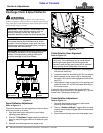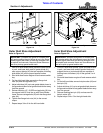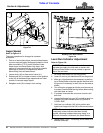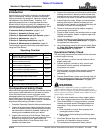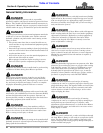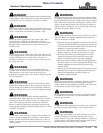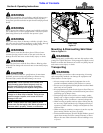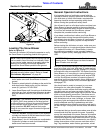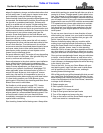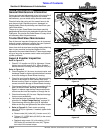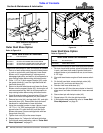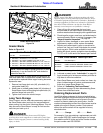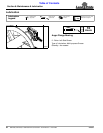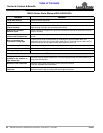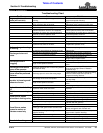
28
Section 5: Operating Instructions
SBL2566, SBL2574, & SBL2584 with S/N 891531+ Snow Blowers 370-478M
3/18/15
Table of Contents
edges, fire hydrants, stumps, and other obstructions that
are not easily seen. It really pays to inspect a new area
and to develop a safe plan before moving snow.
Determine how close to the ground the Snow Blower can
be operated. Set skid shoes to hold the Snow Blower off
the ground at a predetermined height. Surfaces with
gravel or crushed rock will require a higher setting than
hard flat surfaces such as asphalt and concrete. Never
set Snow Blower so low as to pick-up gravel and/or rock.
Determine wind direction and devise a removal plan that
will allow wind to carry blown snow away from the
operator. Snow discharged out the Snow Blower and
blown back at you will obstruct your view and can totally
block your vision of work.
Determine direction to blow snow that will not create a
driving hazard for other vehicles and rotate chute to blow
snow in that direction. To minimize work, do not blow
snow over an area that has already been cleared of snow
and never rotate chute to blow snow toward the skid
steer/tractor and/or operator as hard objects can be
thrown from the discharge chute.
Set spout deflector angle. The angle will vary depending
on how far snow is to be blown, how light and fluffy the
snow is, and how wet and heavy it is.
Some adjustments to the chute rotation, spout deflector
angle, and skid shoe height may be necessary after
traveling a few feet. If you need to get off the skid steer or
tractor to make adjustments, you must stop your
machine, turn hydraulic functions off, disengage PTO
when applicable, place skid steer/tractor in park or in
neutral with park brake set, shut engine off, remove
switch key, and wait for all components to come to a
complete stop before dismounting your skid steer/tractor.
It is now time to position your Snow Blower at your
starting point. Once there, stop travelling and lower Snow
Blower down onto its skid shoes.
Set throttle at an idle speed, engage PTO if tractor
mounted, and turn hydraulic function on. Listen for
unusual clicking or knocking sounds as the auger and
impeller start rotating. If everything sounds fine increase
engine speed to a recommended operating speed. If an
unusual sound is heard, shut your machine down
immediately, investigate the cause, and make necessary
repairs before continuing.
Start traveling forward while blowing snow. Always blow
snow while traveling at a speed that will allow you to be in
control at all times. Change speed if travel speed is too
fast. Only change to a higher speed if you are certain it
will be safe. The heavier and deeper the snow the slower
you will need to travel. If your unit is tractor mounted and
powered with a rear mount HRS, maintain recommended
PTO speed and use a lower gear selection to maintain
proper travel speed. If your unit is skid steer mounted,
you should set your high/low gear selection in the low
range and vary your engine speed to maintain proper
travel speed.
Do not use rear view mirrors to view direction of travel
while backing up. Instead, turn your head to look where
you are traveling. It is very important that you get a full
field of view to prevent an accident.
Beware of obstacles along side your machine while
making turns traveling forward and backing-up. Never
swing the Snow Blower into fire hydrants, mailboxes,
buildings, vehicles, fences, trees, or other standing
obstacles. Shift to a lower gear when possible and travel
very slow when in a tight situation to allow time to react.
Stop your skid steer or tractor before hitting an obstacle.
Once you have reached end of travel, stop your skid steer
or tractor, raise the Snow Blower up, and return to the
front of your work to make another run at blowing snow. It
is not necessary to disengage hydraulics while returning
to the front of your work.
Once at the front, line up your Snow Blower with your
next starting point, lower unit down onto its skid shoes
until all pressure is off the loader arms, and begin
traveling forward blowing snow.
With a little practice you will be pleased with what you and
your Land Pride Snow Blower can do. Whether you are
done blowing snow, need to take a break, or just need to
make a few adjustments to the Snow Blower, remember
to always do the following:
• Reduce engine rpm
• Shut hydraulic functions off
• Disengage PTO if tractor mounted
• Stop on level ground and set park brake
• Turn off the engine and remove the key
• Stay on the tractor until the Snow Blower auger and
rotor have come to a complete stop.



